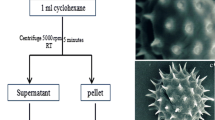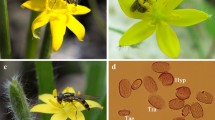Summary
In order to understand the nature of interspecific barriers in Populus, we have explored pollen/pistil interactions in intra- and interspecific crosses Populus nigra x P. nigra and P. nigra x P. alba. The kinetics of pollen-tube growth demonstrated that P. nigra and P. alba pollen tubes have distinct behavioral patterns inside P. nigra pistils. P. alba pollen tubes exhibit an unique S-shaped growth curve and an arrested growth site near the sylodium. P. nigra pollen tubes exhibit two growth phases, in the stigmatic tissues and in the ovarian cavity respectively. P. nigra and P. alba curves diverge 5 h after controlled pollination and could be related to a change in the physiology of the P. nigra pollen tube, which shifts from an autotrophic to a heterotrophic type of nutrition. Protein analysis of pollinated stigmatic extracts (0,6 and 20 h after pollination) revealed qualitative and quantitative differences that are related to the presence of either P. nigra or P. alba pollen tubes inside the stigmatic tissues. Increasing numbers of protein bands were detectable from 0 to 20 h after pollination only in intraspecific cross. Glycoproteins were detected, and the differences observed were dependent of the cross. β-Galactosidase activity was found in pollinated stigmas, but an increase in its activity (one isozyme of pHi 4.2) between 6 h and 20 h after pollination was detected only in the intraspecific cross. This enzyme could play a role in heterotrophic pollen-tube nitrition, and its activity could be the final result of a series of interactions started by the initial pollen-stigma dialog.
Similar content being viewed by others
References
Ascher PD (1986) Incompatibility and incongruity: two mechanisms preventing gene transfer between taxa. In: Mulcahy DL, Mulcahy GB, Ottaviano E (eds) Biotechnology and ecology of pollen. Springer, Berlin Heidelberg New York, pp 251–256
Ashford AE, Knox RB (1980) Characteristics of pollen diffusates and pollen wall cytochemistry in poplars. J Cell Sci 44:1–17
Calzoni LC, Speranza A (1989) Glycoproteins in germinating apple pollen. Plant Physiol Biochem 27:219–225
Cruzan MB (1986) Pollen tube distribution in Nicotiana glauca: evidence for density dependant growth. Am J Bot 73:902–907
Dopico B, Nicolas G, Labrador E (1989) Partial purification of cell wall β-galactosidase from Cicer arietinum epicotyls. Relationships with cell wall autolytic processes. Physiol Plant 75:458–464
Dumas C, Knox RB (1983) Callose and determination of pistil viability and incompatibility. Theor Appl Genet 67:1–10
Fritz NK, Hanneman RE (1989) Interspecific incompatibility due to stylar barriers in tuber-bearing and closely related non-tuberbearing Solanums. Sex Plant Reprod 2:184–192
Gaget M (1988) Incompatibilité interspécifique chez Populus: Effet mentor. PhD thesis, Université Lyon I, France
Gaget M, Said C, Dumas C, Knox RB (1984) Pollen-pistil interactions in interspecific crosses of Populus (sections Aigeiros and Leuce): pollen adhesion, hydration and callose response. J Cell Sci 72:173–184
Gaget M, Villar M, Dumas C (1989b) Sexual reproduction in Populus. II. Informational molecules of the pollen grain. Ann Sci For 46 [Suppl]:67–71
Gaude T, Dumas C (1987) Molecular and cellular events of self-incompatibility. Int Rev Cytol 107:333–366
Guries RP, Stettler RF (1976) Prefertilization barriers to hybridization in poplars. Silvae Genet 25:37–43
Hamilton D (1976) Intersectional imcompatibility in Populus. PhD thesis, Australian University, Canberra, Australia
Hawkes R (1982) Identification of Concanavalin A binding proteins after sodium dodecyl sulfate gel electrophoresis and protein blotting. Anal Biochem 123:143–146
Heslop-Harrison J, Heslop-Harrison Y (1970) Evaluation of pollen viability by enzymatically induced fluorescence, intracellular hydrolysis of fluorescein diacetate. Stain Technol 45:115–120
Hogenboom NG (1984) Incongruity: non-functioning of intercellular and intracellular partner relationships through non-matching information. In: Linskens HF, Heslop-Harrison J (eds) Cellular interactions. (Encyclopedia of plant physiology, new series vol 17). Springer Berlin Heidelberg New York, pp 640–654
Knox RB, Willing RR, Ashford AE (1972a) Role of pollen wall proteins as recognition substances in interspecific incompatibility in poplars. Nature 237:381–383
Knox RB, Willing RR, Pryor LD (1972b) Interspecific hybridization in poplars using recognition pollen. Silvae Genet 21:65–69
Linskens HF, Havez R, Lindner R, Saldem M, Randoux A, Laniez D, Coustaut D (1969) Etude des glycanne-hydrolases au cours de la croissance du pollen chez Petunia habrida auto-incompatible. CR Acad Sci Paris 269:1855–1857
Martin FW (1959) Staining and observing pollen tubes in the style by means of fluorescence. Stain Technol 34:125–128
Melchior GH, Seitz FW (1968) Interspezifische Kreuzungsterilität innerhalb der Pappelsketion Aigeiros. Silvae Genet 17:88–93
Mosseler A (1989) Interspecific pollen-pistil incongruity in Salix. Can J For Res 19:1161–1168
Mulcahy DL, Mulcahy GB (1983) A comparison of pollen tube growth in biand trinucleate pollen. In: Mulcahy DL, Ottaviano E (eds) Pollen: biology and implications for plant breeding. Elsevier Biomedical, New York, pp 29–34
Raff J, Knox RB (1983) Pollen tube growth in Prunus avium. In: Williams EG, Knox RB, Gilbert P, Bernhardt P (eds) Pollination 82. School of Botany, University of Melbourne, Australia, pp 123–134
Rosen WG (1971) Pistil-pollen interactions in Lilium. In: HeslopHarrison J (ed) Pollen, development and physiology. Butterworths, London, pp 177–185
Rosenfield CL, Matile PH (1979) Glycosidases in pear pollen tube development. Plant Cell Physiol 20:605–613
Rougier M, Jnoud N, Dumas C (1988) Localization of adenylate cyclase activity in Populus: its relation to pollen-pistil recognition and incompatibility. Sex Plant Reprod 1:140–149
Russell SD (1986) Biphasic pollen tube growth in Plumbago zeylanica. In: Mulcahy DL, Mulcahy GB, Ottaviano E (eds) Biotechnology and ecology of pollen. Springer, Berlin Heidelberg New York, pp 385–390
Sharma N, Singh MB, Malik CP (1981) Relation of glycosidases to Amaryllis vitata pollen tube growth. Plant Cell Physiol 22:927–931
Singh MB, Knox RB (1984) Quantitative cytochemistry of β-galactosidase in normal and enzyme deficient (gal) pollen of Brassica campestris: application of the indigogenic method. Histochem J 16:1273–1296
Singh MB, Knox RB (1986) β-galactosidase of Lilium pollen. Phytochemistry 24:1639–1643
Snow AA, Spira TP (1991) Pollen vigour and the potential for sexual selection in plants. Nature 352:796–797
Stettler RF, Koster R, Steenackers V (1980) Interspecific crossability studies in poplars. Theor Appl Genet 58:273–282
Villar M (1987) Incompatibilité interspécifique chez Populus: Approches physiologique et biochimique. PhD thesis, Université Lyon I, France
Villar M, Gaget M, Dumas C (1987a) The route of pollen tube from stigma to ovule in Populus nigra: a new look. Ann Sci For 44:259–264
Villar M, Gaget M, Said C, Knox RB, Dumas C (1987b) Incompatibility in Populus: structural and cytochemical characteristics of the receptive stigmas of Populus alba and Populus nigra. J Cell Sci 87:483–490
Villar M, Gaget M, Dumas C (1988) Micro-isoelectrofocusing of proteins from single stigmas of Populus. Can J For Res 18:1261–1264
Author information
Authors and Affiliations
Rights and permissions
About this article
Cite this article
Villar, M., Gaget, M., Rougier, M. et al. Pollen-pistil interactions in Populus: β-galactosidase activity associated with pollen-tube growth in the crosses P. nigra x P. nigra and P. nigra x P. alba . Sexual Plant Reprod 6, 249–256 (1993). https://doi.org/10.1007/BF00231902
Issue Date:
DOI: https://doi.org/10.1007/BF00231902




